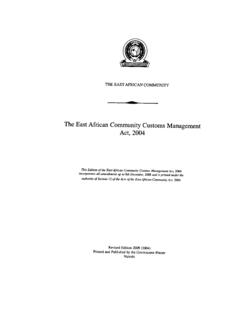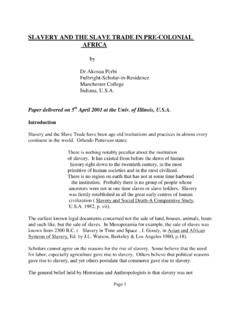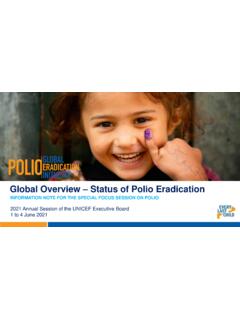Transcription of The future of food and agriculture Alternative pathways to ...
1 SUMMARY VERSIONThe futureof food andagricultureAlternativepathways to 20502 SUMMARY VERSIONFood and agriculture Organization of the United NationsRome, 2018 The futureof food andagricultureAlternativepathways to 2050 Required citation:FAO. 2018. The future of food and agriculture Alternative pathways to 2050. Summary version. Rome. 60 pp. Licence: CC BY-NC-SA designations employed and the presentation of material in this information product do not imply the expression of any opinion whatsoever on the part of the food and agriculture Organization of the United Nations (FAO) concerning the legal or development status of any country, territory, city or area or of its authorities, or concerning the delimitation of its frontiers or boundaries.
2 The mention of specific companies or products of manufacturers, whether or not these have been patented, does not imply that these have been endorsed or recommended by FAO in preference to others of a similar nature that are not views expressed in this information product are those of the author(s) and do not necessarily reflect the views or policies of FAO. ISBN 978-92-5-130989-6 FAO, 2018 Some rights reserved. This work is made available under the Creative Commons Attribution-NonCommercial-ShareAlike IGO licence (CC BY-NC-SA IGO; ). Under the terms of this licence, this work may be copied, redistributed and adapted for non-commercial purposes, provided that the work is appropriately cited.
3 In any use of this work, there should be no suggestion that FAO endorses any specific organization, products or services. The use of the FAO logo is not permitted. If the work is adapted, then it must be licensed under the same or equivalent Creative Commons license. If a translation of this work is created, it must include the following disclaimer along with the required citation: This translation was not created by the food and agriculture Organization of the United Nations (FAO). FAO is not responsible for the content or accuracy of this translation. The original [Language] edition shall be the authoritative mediation relating to disputes arising under the licence shall be conducted in accordance with the Arbitration Rules of the United Nations Commission on International Trade Law (UNCITRAL) as at present in materials.
4 Users wishing to reuse material from this work that is attributed to a third party, such as tables, figures or images, are responsible for determining whether permission is needed for that reuse and for obtaining permission from the copyright holder. The risk of claims resulting from infringement of any third-party-owned component in the work rests solely with the , rights and licensing. FAO information products are available on the FAO website ( ) and can be purchased through Requests for commercial use should be submitted via: Queries regarding rights and licensing should be submitted to: 4 ABBREVIATIONS 6 FOREWORD 8 THE future OF food AND agriculture .
5 THE OVERARCHING CONCERN AND KEY MESSAGES 111 Overview 162 Alternative scenarios for possible futures 243 Managing food demand and changing people s dietary preferences 304 Sustainably addressing the scarcity and reduced quality of land and water resources 355 Addressing poverty and inequality to achieve food security and nutrition goals 426 Tackling the nexus between climate change, agricultural sectors and livelihoods 527 Concluding remarks 58 This booklet summarizes the key messages and findings of the report The future of food and agriculture Alternative pathways to figures and graphs are taken from that publication.
6 | 4 |ACKNOWLEDGEMENTSThis report was prepared by the FAO Global Perspectives Studies (GPS) team of the Economic and Social Development (ES) Department. The GPS team members Lorenzo Giovanni Bell , Senior Economist, Team Leader and lead author of the report, Katerina Kavallari, Marc M ller and Lan Huong Nguyen, Economists, and Dominik Wisser, Natural Resources Specialist, wrote the report after carrying out the design of the study and related modelling, gathering data and information, and analysing quantitative and qualitative findings. The whole process largely benefited from the overall guidance of Kostas Stamoulis, Assistant Director-General of the ES Department.
7 The preparation of the first draft was supervised by Rob Vos, former Director of FAO s Agricultural Development Economics Division (ESA) and current Director of the Markets, Trade and Institutions Division at the International food Policy Research Institute (IFPRI). Marco Vinicio S nchez Cantillo, Deputy Director of ESA, supervised the finalization of the report and provided important editorial inputs. Significant technical inputs and advice were provided by specialists from different FAO departments during three preparatory workshops held in July and December 2016 and November 2017. Critical contributions were provided by:Economic and Social Development Department (ES): Katherine Baldwin, Carlo Cafiero, Andrea Cattaneo, Filippo Gheri, G nter Hemrich, Holger Matthey, Carlos Mielitz Netto, Salar Tayyib and Francesco and Consumer Protection Department (AG):Teodardo Calles, Alessandra Falcucci, Hilde Kruse, Anne Mottet, Carolyn Opio, Timothy Robinson, Henning Steinfeld, Giuseppe Tempio and Aimable and Aquaculture Department (FI): Manuel Barange and Stefania , Biodiversity, Land and Water Department (CB):Gianluca Franceschini, Jippe Hoogeveen and Nadia Scialabba.
8 Strategic Programmes (SPs): Panagiotis Karfakis and Brave Ndisale (SP1), Clayton Campanhola, Jean-Marc Faur s and Ewald Rametsteiner (SP2), Maya Takagi (SP3), Jamie Morrison (SP4) and Dominique Burgeon (SP5).Office of the Director-General (ODG): Yasaman Matinroshan.| 5 |THE future OF food AND AGRICULTUREFAO gratefully acknowledges valuable contributions from: Linda Arata (Universit Cattolica del Sacro Cuore, Italy), Wolfgang Britz (University of Bonn, Germany), G nther Fischer (International Institute for Applied Systems Analysis), Steve Frolking (University of New Hampshire, USA), David Hallam (former Director of the Trade and Markets Division, FAO), Dominique van der Mensbrugghe (Purdue University, USA), Daniele Moro (Universit Cattolica del Sacro Cuore, Italy) and Paolo Sckokai (Universit Cattolica del Sacro Cuore, Italy).
9 Jim Curtiss, Editorial Advisor, edited the various versions of the report. Daniela Verona, Publishing Expert, prepared the graphics and the final Rucci, Outreach Specialist, coordinated the publication and communications workflow, while Christopher Emsden, Communications Officer, advised on the preparation of key messages and Eleonora Boni, Office Assistant, supported the preparation of the summary version of the report. Anna Doria Antonazzo, Office Assistant, provided administrative support. The Publishing Group of FAO s Office for Corporate Communication (OCC) provided editorial, translation and printing support.
10 | 6 |AfDBAfrican Development Bank BAUB usiness as usual scenarioCFSC ommittee on World food SecurityCO2 Carbon dioxideCO2eqCarbon dioxide equivalent COP21 Twenty-first Conference of the Parties of the United Nations Framework Convention on Climate Change (Paris, 2015) EAP east Asia and the PacificECAE urope and Central AsiaENVISAGE Environmental Impact and Sustainability Applied General Equilibrium modelFAOFood and agriculture Organization of the United NationsFDIF oreign direct investmentGAEZG lobal Agro-Ecological Zones (FAO-IIASA)GAPSG lobal agriculture Perspectives System (FAO)GHGG reenhouse gassesGLEAMG lobal Livestock Environmental Assessment Model (FAO)
















